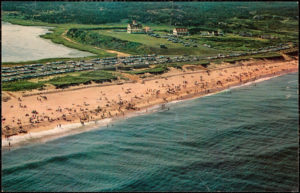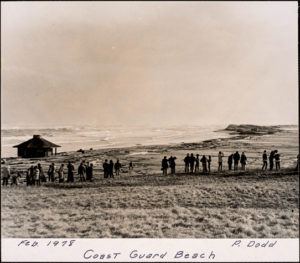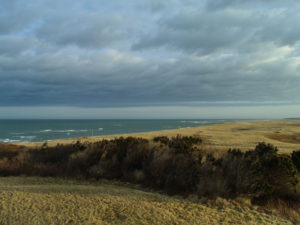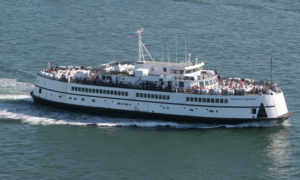
An aerial shot of how Coast Guard Beach looked during the 1960’s with its huge parking lot. Courtesy of the Eastham Historical Society.
Forty years ago the Cape was rocked by the legendary Blizzard of ’78 one of the most infamous storms in the history of New England. It single-handedly changed the landscape of Cape Cod. What many called the ‘Storm of the Century’ began creeping into New England on Monday February 6, 1978. It would piggyback on a storm two weeks earlier which had dumped more than two-feet of snow in places when rain had been predicted. This storm would follow up with an even stronger punch bringing heavy snow to much of New England. Cape Cod, as is often the case, would see its snowfall amounts tapered by rain. However the tidal event which accompanied the storm would drastically alter the Cape’s shoreline.
A Canadian high pressure system would slow the powerful storm down, leaving it to impact New England for upwards of thirty-six hours. Although the Cape only received a paltry by comparison 8-12 inches of snow by the end of the day Monday, despite the snow changing to rain, the power outages came by the boatload. Wind gusts were clocked at 92 mph at the Chatham Coast Guard Station with the peak gust of 111 mph being clocked in Scituate, Massachusetts. Thousands of vehicles ended up stranded on the highways around New England due to the rapidly deteriorating conditions. This was partially due to the timing of the storm, as it intensified during work and school hours. It was also partially due to the fact that it was forecast to be weaker than it ended up being.

A group of people overlooking the flooded parking lot at Coast Guard Beach with the bath house in the middle during the Blizzard of ’78. Courtesy of the Eastham Historical Society.
Tuesday February 7th dawned calm on the Cape. This was a false hope though as news reports explained it was the eye of the storm, much the same as a hurricane. It was during this eerie calm that people ventured out and were able to start to get a grasp on the damage the wind and waves had caused.
Monomoy Island in Chatham was split, creating North and South Monomoy Islands. These would remain separated until eventually reconnecting to mainland Cape Cod around Thanksgiving 2006. Commercial Street in Provincetown was underwater. There had also been floods at Herring Cove Beach in Provincetown and Ballston Beach in Truro. The breach in Truro split Pamet Road into the North and South Pamet Roads of today.
Chatham’s North Beach had been breached in as many as twenty places with four of the famed cottages being destroyed and others damaged. Due to the astronomically high tides there was even a period where the Outer Cape was an island. A sixteen-foot tide washed across Eastham through Fort Hill and out to Cape Cod Bay leaving the area under three-feet of water for a time. The flooding tides reached as high as seventeen-feet at Town Neck Beach in Sandwich and more than thirteen-feet at Corporation Beach in Dennis.
The power and destruction of the Blizzard of ’78 can be summed up best in the enduring changes which occurred at Coast Guard Beach in Eastham. First off, ‘Fo’castle’ also known as The Outermost House, a 20×16-foot dune shack made famous in Henry Beston’s 1928 book of the same name, was washed from its location nearly two miles south of the Coast Guard building, along the Nauset Spit. People gathered and watched in shock and awe as not only did the beloved dune shack get claimed by the sea, but also the bath house at Coast Guard Beach. This bath house was located a few hundred yards southeast of the location of the Coast Guard building along the expansive parking lot. The waves which reached more than thirty-feet in height ate away at the dune system along the beach which eventually caused the 350-space parking lot to collapse. As of 2018 due to an average erosion rate of four-feet per year the Coast Guard building itself sits 480-feet from the ocean. According to the Massachusetts Shoreline Change Browser it has lost roughly 300-feet of shoreline since 1969. Today though the beach still stretches south all that remains of the large parking lot and bath house are photos and memories.
When all was said and done nearly one hundred people had lost their lives in the storm overall. Boston received twenty-seven inches of snow, Providence, Rhode Island received similar amounts, with snowfall rates getting as high as four-inches per hour. Damage was reported to be around $520 million ($1.9 billion today). The Blizzard of ’78 was a once in a lifetime storm, changing the shape of Cape Cod permanently in some places. Forty years later it is still fresh in the memories of those who went through it.
By Christopher Setterlund
























